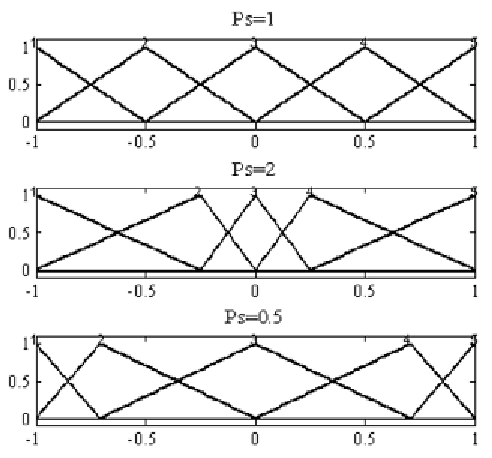Geology Reference
In-Depth Information
tory buildings behavior are symmetric, the num-
ber of membership functions should be odd which
are symmetric with respect to the vertical axis.
Therefore, for input and output variables, five
triangular membership functions are considered.
In order to design these membership functions it
is assumed that all universes of discourses are
normalized to lie between -1 and 1, and the first
and last membership functions have their apexes
at -1 and 1, respectively. Also, the apex of each
triangle is in one point with the tip base of two
lateral triangles, and as respects, the universe of
discourse is laid between -1 and 1, so the position
of the apexes of each triangular membership
function
C
( )
can be found with the parameter
P
s
and the number of membership functions as bel-
low
where
N
is the number of membership functions.
It can be concluded that if
P
s
is less than one the
centers are spaced out and if
P
s
is more than one,
the centers are closed together in the center. Figure
5 depicts five membership functions with three
different
P
s
values.
Another design challenge of fuzzy systems is
to find the rule bases of the system. There are
different strategies to get the rule bases, which
most of them are often based on the experiences
and knowledge of human beings, but, in intelligent
design methods such as design with genetic al-
gorithms, some characteristic parameters are
considered to design rule bases. In this research,
according to the reference (Park et al., 1995), two
characteristic parameters are used which one is
spacing parameter
P
i
for the inputs and the output,
and the other one is the angle
θ
for inputs. The
spacing parameter
P
i
determines the layout of
different values of the inputs towards the origin
(zero point). Therefore, the space parameter,
P
i
,
grids the rule base space, so that these lines divide
this region into different regions with the number
of output linguistic variables. If the values of the
Ps
i
n
N
−
1
C
=
,
n
=
,
i
= −
n
, ...,
0 1
,
, ...,
n
i
1
1
1
2
1
(24)
Figure 5. Designed membership functions with different P
s


Search WWH ::

Custom Search